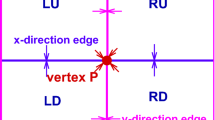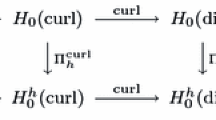Abstract
The role of involutions in energy stability of the discontinuous Galerkin (DG) discretization of Maxwell and magnetohydrodynamic (MHD) systems is examined. Important differences are identified in the symmetrization of the Maxwell and MHD systems that impact the construction of energy stable discretizations using the DG method. Specifically, general sufficient conditions to be imposed on the DG numerical flux and approximation space are given so that energy stability is retained. These sufficient conditions reveal the favorable energy consequence of imposing continuity in the normal component of the magnetic induction field at interelement boundaries for MHD discretizations. Counterintuitively, this condition is not required for stability of Maxwell discretizations using the discontinuous Galerkin method.
Access this chapter
Tax calculation will be finalised at checkout
Purchases are for personal use only
Preview
Unable to display preview. Download preview PDF.
Similar content being viewed by others
References
T.J. Barth. Numerical methods for gasdynamic systems on unstructured meshes. In Kröner, Ohlberger, and Rohde, editors, An Introduction to Recent Developments in Theory and Numerics for Conservation Laws, volume 5 of Lecture Notes in Computational Science and Engineering, pages 195–285. Springer-Verlag, Heidelberg, 1998.
T.J. Barth. Simplified discontinuous Galerkin methods for systems of conservation laws with convex extension. In Cockburn, Karniadakis, and Shu, editors, Discontinuous Galerkin Methods, Volume 11 of Lecture Notes in Computational Science and Engineering. Springer-Verlag, Heidelberg, 1999.
T.J. Barth. On the discontinuous Galerkin approximation of compressible ideal magnetohydrodynamics I: Energy stable discretizations. In preparation, 2005.
J.U. Brackbill and D.C. Barnes. The effect of nonzero Δ · B on the numerical solution of the magnetohydrodynamic equations. J. Comp. Phys., 35:426–430, 1980.
N. Besse and D. Kröner. Convergence of locally divergence-free discontinuous Galerkin methods for the induction equations of the MHD system. Technical Report Submitted to M2AN, Wolfgang Pauli Institute, Austria, 2004.
G. Boillat. Involutions des systéms conservatifs. C. R. Acad. Sci. Paris, Sere I, 307:891–894, 1988.
A. Bossavit. Computational Electromagnetism, Variational Formulations, Complementarity, Edge Elements. Academic Press, San Diego, 1998.
P.B. Bochev and A.C. Robinson. Matching algorithms and physics: Exact sequences of finite element spaces. In D. Estep and S. Tavener, editors, Collected Lectures on the Preservation of Stability Under Discretization, Philadephia, 2002. SIAM.
B. Cockburn, S. Hou, and C.W. Shu. TVB Runge-Kutta local projection discontinuous Galerkin finite element method for conservation laws IV: The multidimensional case. Math. Comp., 54:545–581, 1990.
B. Cockburn, S.Y. Lin, and C.W. Shu. TVB Runge-Kutta local projection discontinuous Galerkin finite element method for conservation laws III: One dimensional systems. J. Comp. Phys., 84:90–113, 1989.
B. Cockburn, F. Li, and C.W. Shu. Locally divergence-free discontinuous Galerkin methods for Maxwell equations. J. Comp. Phys., 194:588–610, 2004.
B. Cockburn and C.W. Shu. The Runge-Kutta discontinuous Galerkin method for conservation laws V: Multidimensional systems. Technical Report 201737, Institite for Computer Applications in Science and Engineering (ICASE), NASA Langley R.C., 1997.
A. Csik. Upwind Residual Distribution Schemes for General Hyperbolic Conservation Laws with Application to Ideal Magnetohydrodynamics. PhD thesis, University of Leuven, Belgium, 2002.
C. Dafermos. Quasilinear hyperbolic systems with involutions. Arch. Rational Mech. Anal., 106:373–389, 1986.
A. Dedner, F. Kemm, D. Kröner, C.-D. Munz, T. Schnitner, and M. Wesenberg. Hyperbolic divergence cleaning for the MHD equations. J. Comp. Phys., 175:645–673, 2002.
B. Einfeldt, C. Munz, P. Roe, and B. Sjögreen. On Godunov-type methods near low densities. J. Comp. Phys., 92:273–295, 1992.
S.K. Godunov. An interesting class of quasilinear systems. Dokl. Akad. Nauk. SSSR, 139:521–523, 1961.
S.K. Godunov. The symmetric form of magnetohydrodynamics equation. Num. Meth. Mech. Cont. Media, 1:26–34, 1972.
A. Harten, P.D. Lax, and B. van Leer. On upstream differencing and Godunov-type schemes for hyperbolic conservation laws. SIAM Rev., 25:35–61, 1983.
J.M. Hyman and M. Shashkov. Mimetic discretizations for Maxwell’s equations. J. Comp. Phys., 151:881–909, 1999.
J. Jaffre, C. Johnson, and A. Szepessy. Convergence of the discontinuous Galerkin finite element method for hyperbolic conservation laws. Math. Models and Methods in Appl. Sci., 5(3):367–386, 1995.
C. Johnson and J. Pitkäranta. An analysis of the discontinuous Galerkin method for a scalar hyperbolic equation. Math. Corny., 46:1–26, 1986.
G. Jiang and C.-W. Shu. On a cell entropy inequality for discontinuous galerkin methods. Math. Corny., 62:531–538, 1994.
P. Lesaint and P.A. Raviart. On a finite element method for solving the neuton transport equation. In C. de Boor, editor, Mathematical Aspects of Finite Elements in Partial Differential Equations, pages 89–145. Academic Press, 1974.
M.L. Merriam. An Entropy-Based Approach to Nonlinear Stability. PhD thesis, Stanford University, 1988.
M.S. Mock. Systems of conservation laws of mixed type. J. Diff. Eqns., 37:70–88, 1980.
J.C. Nedelec. Mixed finite elements in ℝ3. Numer. Math., 35:315–341, 1980.
S. Osher. Riemann solvers, the entropy condition, and difference approximations. SIAM J. Numer. Anal, 21(2):217–235, 1984.
K.G. Powell. An approximate Riemann solver for magnetohydrodynamics (that works in more than one dimension). Technical Report 94-24, Institite for Computer Applications in Science and Engineering (ICASE), NASA Langley R.C., 1994.
W.H. Reed and T.R. Hill. Triangular mesh methods for the neutron transport equation. Technical Report LA-UR-73-479, Los Alamos National Laboratory, Los Alamos, New Mexico, 1973.
C.-W. Shu. Discontinuous Galerkin methods for convection-dominated problems. In Barth and Deconinck, editors, High-Order Discretization Methods in Computational Physics, Volume 9 of Lecture Notes in Computational Science and Engineering. Springer-Verlag, Heidelberg, 1999.
G. Tóth. The Δ · B = 0 constraint in shock-capturing magnetohydrodynamics codes. J. Comp. Phys., 161:605–652, 2000.
K.S. Yee. Numerical solution of initial boundary value problems involving Maxwell’s equations in isotropic media. IEEE Trans. Ant. Prop., AP-14:302–307, 1966.
Author information
Authors and Affiliations
Editor information
Editors and Affiliations
Rights and permissions
Copyright information
© 2006 Springer Science+Business Media, LLC
About this paper
Cite this paper
Barth, T. (2006). On the Role of Involutions in the Discontinuous Galerkin Discretization of Maxwell and Magnetohydrodynamic Systems. In: Arnold, D.N., Bochev, P.B., Lehoucq, R.B., Nicolaides, R.A., Shashkov, M. (eds) Compatible Spatial Discretizations. The IMA Volumes in Mathematics and its Applications, vol 142. Springer, New York, NY. https://doi.org/10.1007/0-387-38034-5_4
Download citation
DOI: https://doi.org/10.1007/0-387-38034-5_4
Publisher Name: Springer, New York, NY
Print ISBN: 978-0-387-30916-3
Online ISBN: 978-0-387-38034-6
eBook Packages: Mathematics and StatisticsMathematics and Statistics (R0)




